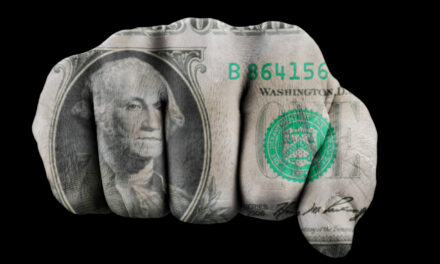Suppose one of you wants to build a tower. Won’t you first sit down and estimate the cost to see if you have enough money to complete it? For if you lay the foundation and are not able to finish it, everyone who sees it will ridicule you, saying, “This person began to build and wasn’t able to finish.”
— Luke 14:28-30
Seize the Towers
The highlight of the 2024 Grammys last month was the duet by Tracy Chapman and Luke Combs of Chapman’s 1988 hit “Fast Car.” The performers teamed up to deliver several minutes of musical magic.
The otherwise hollow affair was held at the posh Crypto.com Arena — formerly known as the Staples Center — in downtown Los Angeles. This is one of the few places in LA that will pull the rich and famous away from their protected westside enclaves in Malibu Colony and Beverly Hills.
The exterior view from the arena’s Star Plaza entrance delivers a fabulous, Los Angeles-style aesthetic. One that simultaneously pleases and lacerates the eye.
Beyond the foreground statues of famous LA athletes sits the Oceanwide Plaza development. This trio of incomplete luxury towers was abandoned in 2019. That was when the developer, Oceanwide Holdings ran out of money.
In January, talented graffiti artists began tagging the vacant Oceanwide Plaza towers. This is no small feat. It requires scaling the buildings’ unfinished exteriors and then spray-painting creative phrases using colorful palettes and designs. Some then base jumped off and paraglided down Flower Street.
An outfit called the People’s City Council of Los Angeles collective — an abolitionist, anti-capitalist and anti-imperialist, collective amplifying the voice of the people — characterized it as follows:
It’s a perfect depiction of Los Angeles — political corruption, real estate, ‘crime’ + LAPD, the people making beautiful art. The graffiti is beautiful. Seize the towers.
Beauty, no doubt, is in the eye of the beholder. There may be differing opinions on the aesthetic appeal of the vibrant scribbles now adorning the Oceanwide Plaza towers. Regardless, the collective is onto something.
Without question, the graffiti is a perfect depiction of LA’s political corruption and crime.
Racketeering
At this point, Oceanwide Holdings, a China-based development company, has officially Shanghaied the dupes at City Hall. Now, city officials are having to use public funds to stop the madness.
Last week, for example, the LA City Council approved an initial $1.1 million to get a handle on things. So far, abandoned construction scaffolding has been removed and new fencing is being installed to stop graffiti artists and derelicts from invading the property.
This is all happening in City Councilman Kevin de León’s 14th District. According to de León, the $1.1 million is to protect the city:
Someone is going to go up there, and they’re going to push the limit and fall to their death. Somehow, someway, the city will be liable for it.
Mr. de León, to his credit, is merely attempting to respond to a mess that was started when his predecessor, former City Councilman José Huizar, was on watch. Huizar represented the 14th District for 15 years. But somewhere in his tenure he got mixed up in some shady stuff.
In late-January, Huizar was sentenced to 13 years in prison for corruption involving at least $1.5 million in pay-for-play cash in exchange for expediting approvals of downtown real estate projects. There’s even video evidence showing $200,000 in bribery money stuffed in a Johnny Walker Blue Label whiskey box along with another $200,000 stuffed into a Don Julio box.
Quite frankly, this sort of corruption grease is applied to big city skids across the globe. Furthermore, it’s small potatoes compared to what goes on in Washington. We don’t like it. We’re merely recognizing the corrupt underbelly of the world we live in.
In this regard, we don’t know if Huizar’s racketeering had anything to do with Oceanwide Plaza. But, at a minimum, he was distracted at the time this failed development was approved.
Hell On Earth
Not far from Oceanwide Plaza, and within the 14th District, is a half square mile of urban decay, where depravity, chaos, addiction, insanity and archaic diseases multiply and ricochet about like metastatic cancer. Centered on the Union Rescue Mission at 545 South San Pedro Street, Skid Row is home to some 10,000 zombies.
There, living within massive homeless encampments amongst spoils of garbage, feces, rats and rot, they roll around on a filthy ground cover composed of fragmented concrete, glass, stone and gravel. Diseases that flourished in the Middle Ages, like typhus and flesh-eating bacteria, infect these street dwellers — and those who try and help them — with remarkable efficiency.
Take Reverend Andy Bales, former CEO of the Union Rescue Mission. He’s a man with a big heart and a personal commitment to action. His late father and grandfather lived homeless in a tent for many years.
After 20 years as CEO of the Union Rescue Mission, Rev. Bales retired in October 2023 and returned to Iowa. Good for him. But, alas, he should have retired a decade earlier.
In the mid-2010s, while passing out water bottles to those he served, Rev. Bales contracted three different deadly bacteria — E. coli, strep and staph. Sadly, this cocktail of toxic microorganisms relentlessly attacked his body, consuming his flesh. For Rev. Bales, his encounter brought him to an important choice: Your leg or your life?
Most days he now gets around in his wheelchair … propelling it up and down the street wearing bike gloves. Occasionally, he wears a prosthetic. Yet, until his retirement last year, he continued his rescue mission with a warm heart and special wisdom. According to Rev. Bales:
Skid Row is the worst man-made disaster in the United States. By far.
If you ever want to witness hell on earth, take a stroll down San Pedro Street through Skid Row on a weekday evening when the Union Rescue Mission serves dinner. Hordes of sufferers flap their arms as they flood the streets from their urban camp sites. “There but for the grace of God go I.”
Ghosts of the Alexandria Hotel
The 14th District is a whacky and wild place. We know the area well. Over more than two decades we worked off and on in downtown LA.
Last year, this was the site of three mega commercial real estate defaults. Specifically, Brookfield Properties’ DTLA fund defaulted on about $1.1 billion of debt tied to three towers between February and May of 2023. These properties include the Gas Company Tower, the 777 Tower and EY Plaza.
The reasons behind the defaults are generally straightforward. The double whammy of higher vacancy rates post-Covid and higher interest rates have turned these buildings from profit generating ventures into huge gaping money pits.
Unfortunately, these mega CRE defaults are not just confined to LA’s 14th District. A new report from real estate data firm ATTOM shows a significant annual spike in U.S. commercial foreclosures in January 2024.
ATTOM’s approach is straightforward. Each month it counts the number of commercial properties with at least one foreclosure filing. In January, the tally came in at 635. That’s 97% more than the same month last year and 17% more than December 2023. According to ATTOM, this is all part of a natural process:
The 97% year-over-year increase signals a revitalizing market that is navigating through the long-term economic shifts following a global event, adapting with resilience and strategic adjustments to new commercial realities.
Maybe ATTOM is right. Maybe this massive increase in foreclosure filings signals a revitalizing market. But at what time horizon?
In LA’s 14th District, not far from the Gas Company Tower now in receivership, sits the Alexandria Hotel. When the doors were opened in 1906, it was Los Angeles’ most elegant hotel. Early guests included President Teddy Roosevelt, King Edward VIII and countless early Hollywood movie stars.
Yet the Alexandria Hotel went bankrupt and closed in 1932. To this day, it still doesn’t stand on its own two feet.
After many ownership changes, closures and reopenings, over many decades, the formerly grand property degenerated in the 1990s to single room occupancy housing, where junkies and pyromaniacs experimented in low bottom hedonism.
And despite revitalization efforts, including recent apartment conversions, today the Alexandria Hotel persists as a mix of market rate and subsidized housing.
Perhaps Oceanwide Plaza, and the many other failing commercial properties throughout the country, will bounce back. Maybe this will happen without first triggering a massive banking crisis.
But if the ghosts of the Alexandria Hotel have their say, these busted properties could be a drag on local municipalities for over a century or more.
[Editor’s note: Do you know the smartest thing you can do during a recession? Simply put your fear aside and do the OPPOSITE of your friends and neighbors. >> Here’s why and how.]




